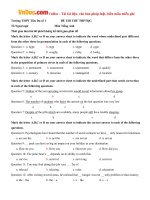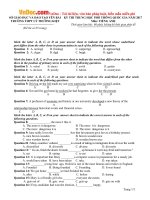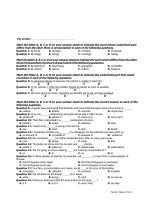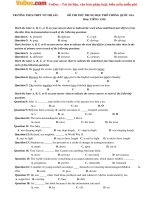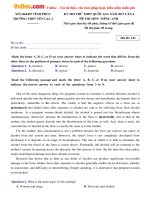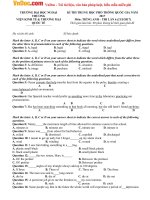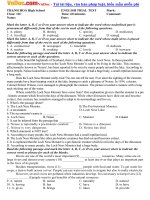Đề thi thử THPT Quốc gia năm 2017 môn Tiếng Anh trường THPT Lý Thường Kiệt, Yên Bái CÓ ĐÁP ÁN (2)
Bạn đang xem bản rút gọn của tài liệu. Xem và tải ngay bản đầy đủ của tài liệu tại đây (283.93 KB, 6 trang )
VnDoc - Tải tài liệu, văn bản pháp luật, biểu mẫu miễn phí
SỞ GIÁO DỤC VÀ ĐÀO TẠO YÊN BÁI KỲ THI TRUNG HỌC PHỔ THÔNG QUỐC GIA NĂM 2017
TRƯỜNG THPT LÝ THƯỜNG KIỆT
Môn: TIẾNG ANH
Thời gian làm bài: 60 phút, không kể thời gian phát đề
(Đề thi có 05 trang)
Mark the letter A, B, C, or D on your answer sheet to indicate the word whose underlined
part differs from the other three in pronunciation in each of the following questions.
Question 1: A. noticed
B. finished
C. supported
D. approached
Question 2: A. clean
B. deal
C. break
D. teach
Mark the letter A, B, C, or D on your answer sheet to indicate the word that differs from the other
three in the position of primary stress in each of the following questions.
Question 3: A. verbal
B. attract
C. awful
D. garden
Question 4: A. decision
B. penalty
C. habitat
D. countryman
Mark the letter A, B, C, or D on your answer sheet to indicate the underlined part that needs
correction in each of the following questions.
Question 5: Driving on the left made my son very surprising when he first visited London.
A
B
C
D
Question 6: Not until he got home he realized he had forgotten to give her the present.
A
B
C
D
Question 7: A professor of economy and history at our university developed a new theory of the
A
B
relationship between historical events and financial crises.
C
D
Mark the letter A, B, C, or D on your answer sheet to indicate the correct answer to each of the
following questions.
Question 8: ______________, the more I like it
A. The more is it dangerous
B. The more it is dangerous
C. The more dangerous it is
D. The more dangerous is it
Question 9: Jane really loves the ___________ box that her parents gave her as a birthday present.
A. nice brown wooden
B. brown wooden nice
C. nice wooden brown
D. wooden brown nice
Question 10 : Many countries’ cultural _________is a result of taking in immigrants from all over the world.
A. diversified
B. diversify
C. diverse
D. diversity
Question 11: " Go on, finish the desert. It needs _________ up because it won't stay fresh until tomorrow."
A. eat
B. eating
C. to eat
D. eaten
Question 12: It is important that Mary _________a computer course in preparation for a steady job.
A. would have taken B. have been taken C. take
D. was taken
Question 13: _________a long time ago, Oxford is one of the most famous universities in England.
A. Founded
B. Being founded
C. Founding
D. It was found
Question 14: We got home _________we had finished the work.
A. after
B. while
C. before
D. during
Question 15: Mary is a friendly girl who _________everyone she meets.
A. gets out of
B. gets over
C. gets up
D. gets on with
Question 16: If my candidate had won the election, I___________ happy.
Trang 1/5
VnDoc - Tải tài liệu, văn bản pháp luật, biểu mẫu miễn phí
A. am
B. would be
C. can be
D. would have been
Question 17: _________always gives me real pleasure.
A. I arrange flowers
B. The flowers are arranged
C. Arranging flowers
D. While arranging flowers
Question 18: ___________he arrived at the bus stop than the bus came.
A. Hardly had
B. No longer had
C. No sooner had
D. Not until had
Question 19: Each of us must take ___________for our actions.
A. probability
B. responsibility
C. ability
D. possibility
Mark the letter A, B, C, or D on your answer sheet
complete each of the following exchanges.
Question 20: Ann: “The hat’s so beautiful. Thanks.”
Kate: “ __________”
A. I am glad you like it.
C. Lucky you!
Question 21: Mary: " Thanks a lot for your help."
Nick: "____________."
A. My happiness
B. My delight
to indicate the most suitable response to
B. Great idea!
D. The same to you!
C. My excitement
D. My pleasure
Mark the letter A, B, C, or D on your answer sheet to indicate the word(s) CLOSEST in meaning to
the underlined word(s) in each of the following questions.
Question 22: I received housing benefit when I was unemployed.
A. out o date
B. out of order
C. out of work
D. out of fashion
Question 23: Once in a while I visit my grandparents on the farm and stay there for some days.
A. Regularly
B. Sometimes
C. Usually
D. Rarely
Mark the letter A, B, C, or D on your answer sheet to indicate the word(s) OPPOSITE in meaning to
the underlined word(s) in each of the following questions.
Question 24: Vietnam’s admission to the Word Trade Organization (WTO) has promoted its trade
relations with other countries.
A. balanced
B. restricted
C. expanded
D. boosted
Question 25: The consequences of the typhoon were disastrous due to the lack of precautionary measures.
A. physical
B. severe
C. beneficial
D. damaging
Mark the letter A, B, C, or D on your answer sheet to indicate the sentence that is closest in
meaning to each of the following questions.
Question 26: The sea was so cold that we couldn't swim in it.
A. The cold sea helped us to swim.
B. We couldn't swim with such a cold sea.
C. The cold sea prevented us from swimming in it.
D. It was such a cold sea that we could swim.
Question 27: She took the train last night, so she wasn’t late.
A. If she had taken the train last night, she would have been late.
B. Unless she hadn’t taken the train last night, she would be late.
C. If she took the train last night, she would be late.
D. If she had not taken the train last night, she would have been late.
Question 28: “Would you like to go to the cinema with me tonight ?” he said
A. He invited me to go to the cinema with him that night.
B. He offered me to go to the cinema with him tonight.
Trang 2/5
VnDoc - Tải tài liệu, văn bản pháp luật, biểu mẫu miễn phí
C. He asked me if I’d like to go to the cinema with him tonight.
D. He would like me to go to the cinema with him this night.
Read the following passage and mark the letter A, B, C, or D on your answer sheet to indicate the
sentence that best combines each pair of sentences in the following questions.
Question 29: They booked the hotel. They had stayed there on their honeymoon.
A. They booked the hotel where they had stayed on their honeymoon.
B. They booked the hotel where they had stayed there on their honeymoon.
C. They booked the hotel which they had stayed on their honeymoon.
D. They booked the hotel which they had stayed there on their honeymoon.
Question 30: Anne jogs every morning. It is very good for her health.
A. Anne jogs every morning and is very good for her health.
B. Anne jogs every morning, which is very good for her health.
C. Anne jogs every morning and then it is very good for her health.
D. Anne jogs every morning that it is very good for her health
Read the following passage and mark the letter A, B, C, or D on your answer sheet to indicate the
correct word or phrase that best fits each of the numbered blanks from 31 to 35.
Wild animals play an important part in the balance of nature, and (31)_________us with many important
products. Birds and other small animals help control insects. Wild animals provide fur, food, and recreation. They
also make our (32)_________more interesting.
Uncontrolled hunting has destroyed much wildlife. People have harmed animals by destroying their habitats.
Many animals, such as the passenger pigeon, have disappeared completely. Others, (33)_________ the whooping
crane, the blue whale, and the American alligator, are in danger of dying out.
Sometimes it is necessary to keep animals from becoming too (34)_________. For example, rabbits and
such rodents as ground squirrels and mice may cause great damage to crops if they are too abundant. Deer may eat
so much vegetation that the herd will starve in winter because no food is left. Predators help (35) _________down
the population of their prey.
Question 31: A. purchase
B. furnish
C. create
D. give
Question 32: A. surroundings
B. atmospheres
C. regions
D. organizations
Question 33: A. gathering
B. multiplying
C. including
D. containing
Question 34: A. dangerous
B. enormous
C. plentiful
D. tiny
Question 35: A. carry
B. bush
C. hold
D. force
Read the following passage and mark the letter A, B, C, or D on your answer sheet to indicate the
correct answer to each of the questions from 36 to 42.
Human Nutrition is the study of how food affects the health and survival of the human body.
Human beings require food to grow, reproduce, and maintain good health. Without food, our bodies could
not stay warm, build and repair tissue, or maintain the heartbeat. Eating the right foods can help us avoid
certain diseases or recover faster when illness occurs. These and other important functions are fueled by
chemical substances in our food called nutrients. Nutrients are classified as carbohydrates, proteins, fats,
vitamins, minerals, and water.
When we eat a meal, nutrients are released from food through digestion. Digestion begins in the
mouth by the action of chewing and the chemical activity of saliva, a watery fluid that contains enzymes,
certain proteins that help break down food. Further digestion occurs as food travels through the stomach
and the small intestine, where digestive enzymes and acids liquefy food and muscle contractions push it
along the digestive tract. Nutrients are absorbed from the inside of the small intestine into the bloodstream
and carried to the sites in the body where they are needed. At these sites, several chemical reactions occur,
which ensures the growth and function of body tissues. The parts of foods that are not absorbed continue
to move down the intestinal tract and are eliminated from the body as feces.
Once digested, carbohydrates, proteins, and fats provide the body with the energy it needs to
maintain its many functions. Scientists measure this energy in kilocalories, the amount of energy needed
Trang 3/5
VnDoc - Tải tài liệu, văn bản pháp luật, biểu mẫu miễn phí
to raise one kilogram of water one degree Celsius. In nutrition discussions, scientists use the term calorie
instead of kilocalorie as the standard unit of measure in nutrition.
Nutrients are classified as essential or nonessential. Nonessential nutrients are manufactured in the
body and do not need to be obtained from food. Examples include cholesterol, a fatlike substance present
in all animal cells. Essential nutrients must be obtained from food sources, because the body either does
not produce them or produces them in amounts too small to maintain growth and health. Essential
nutrients include water, carbohydrates, proteins, fats, vitamins, and minerals.
An individual needs varying amounts of each essential nutrient, depending upon such factors as
gender and age. Specific health conditions, such as pregnancy, breast-feeding, illness, or drug use, make
unusual demands on the body and increase its need for nutrients. Dietary guidelines, which take many of
these factors into account, provide general guidance in meeting daily nutritional needs.
Question 36: The first paragraph mainly discusses ______________.
A. chemical substances in our food
B. the importance of food to human beings
C. the study of human nutrition
D. a variety of essential nutrients to human beings
Question 37: Which of the followings is NOT true about the process of digestion?
A. The small intestine helps the body absorb nutrients.
B. The small intestine covers the whole digestive system.
C. Saliva plays an important role in the first stage of digestion.
D. Nutrients are carried to different sites in the body.
Question 38: The word “maintain” in the third paragraph is closest in meaning to “____________”.
A. keep performing B. obtain
C. provide
D. carry on making
Question 39: According to the passage, which of the following provides energy for the body?
A. Proteins, fats, and minerals
B. Proteins, vitamins, and carbohydrates
C.
Carbohydrates, minerals, and water D. Carbohydrates, proteins, and fats
Question 40: In nutrition discussions, the standard unit used to measure nutrients is____________.
A. kilocalorie
B. kilogram
C. gram
D. calorie
Question 41: The word “which” in the last paragraph refers to “____________”.
A. general guidance
B. dietary guidelines
C. nutritional needs
D. unusual demands
Question 42: Which of the following is NOT mentioned in the passage?
A. The body’s need of nutrients
B. The effects of food on the body
C. Classification of nutrients
D. Food sources from animals
Read the following passage and mark the letter A, B, C, or D on your answer sheet to indicate the
correct answer to each of the questions from 43 to 50.
Most of us know a little about how babies learn to talk. From the time infants are born, they hear
language because their parents talk to them all the time. Between the ages of seven and ten months, most
infants begin to make sounds. They repeat the same sounds over and over again. This is called babbling.
When babies babble, they are practicing their language.
What happens, though, to children who can not hear? How do deaf children learn to communicate?
Recently, doctors have learned that deaf babies babble with their hands. Laura Ann Petitto, a psychologist,
observed three hearing infants with English-speaking parents and two deaf infants with deaf parents using
American Sign Language (ASL) to communicate. Dr. Petitto studied the babies three times: at 10, 12, and
14 months. During this time, children really begin to develop their language skills.
Trang 4/5
VnDoc - Tải tài liệu, văn bản pháp luật, biểu mẫu miễn phí
After watching and videotaping the children for several hundred hours, the psychologist and her
assistants made many important observations. For example, they saw that the hearing children made
varied motions with their hands. However, there appeared to be no pattern to these motions. The deaf
babies also made different movements with their hands, but these movements were more consistent and
deliberate. The deaf babies seemed to make the same hand movements over and over again. During the
four-month period, the deaf babies’ hand motions started to resemble some basic hand-shapes used in
ASL. The children also seemed to prefer certain hand-shapes.
Hearing infants start first with simple syllable babbling, then put more syllables together to sound
like real sentences and questions. Apparently, deaf babies follow this same pattern, too. First, they repeat
simple hand-shapes. Next, they form some simple hand signs and use these movements together to
resemble ASL sentences.
Linguists believe that our ability for language is innate. In other words, humans are born with the
capacity for language: It does not matter if we are physically able to speak or not. Language can be
expressed in different ways – for instance, by speech or by sign. Dr. Petitto believes this theory and wants
to prove it. She plans to study hearing children who have one deaf parent and one hearing parent. She
wants to see what happens when babies have the opportunity to learn both sign language and speech. Does
the human brain prefer speech? Some of these studies of hearing babies who have one deaf parent and one
hearing parent show that the babies babble equally with their hands and their voices. They also produce
their first words, both spoken and signed, at about the same time. More studies in the future may prove
that the sign system of the deaf is the physical equivalent of speech.
Question 43: According to paragraph 1, babies begin to babble ______________.
A. at their first moment after birth
B. when they are more than 6 months old
C. at their first experience of language
D. when they first hear their parents talk to them
Question 44: The phrase “the babies” in paragraph 2 refers to ______________in the study.
A. the deaf infants
B. the hearing infants
C. the hearing and deaf infants
D. the disabled infants
Question 45: The word “resemble” in paragraph 3 refers to ______________.
A. studying funny movements
B. producing similar movements
C. making initial movements
D. creating strange movements
Question 46: It is stated in paragraph 3 that both the deaf and the hearing children made movements with
their hands, but ______________.
A. only the hearing children made different movements
B. the hearing children only repeated the same hand motions
C. only the deaf children repeated the same hand motions
D. the deaf children made less consistent hand movements
Question 47: According to paragraph 4, hearing infants learn to talk first by______________.
A. eye movements
B. hand-shapes
C. hand motions
D. babbling
Question 48: The word “real” in paragraph 4 mostly means ____________.
A. original
B. meaningful
C. formal
D. general
Question 49: Which of the following statements is TRUE according to the last paragraph?
A. Language cannot be expressed in different ways.
B. The human brain prefers speech.
C. Babies produce spoken words before signed ones .
Trang 5/5
VnDoc - Tải tài liệu, văn bản pháp luật, biểu mẫu miễn phí
D. Humans are innately able for language.
Question 50: Which of the following could best serve as the title of the passage?
A. Language: Is it Always Spoken?
B. Education for Deaf Children
How do Children Master Language?
D. American Sign Language
C.
__________THE END___________
HƯỚNG DẪN CHẤM ĐỀ THI THPT QUỐC GIA- LỚP 12
NĂM HỌC: 2016-2017
- Tổng số câu: 50
- Mỗi câu đúng: 0,2 điểm = 10 điểm
Câu 1:C
Câu 11:B
Câu 21:D
Câu 31:B
Câu 41:B
Câu 2:C
Câu 12:C
Câu 22:C
Câu 32:A
Câu 42:D
Câu 3:B
Câu 13:A
Câu 23:B
Câu 33:C
Câu 43:B
Câu 4:A
Câu 14:A
Câu 24:B
Câu 34:C
Câu 44:C
Câu 5:C
Câu 15:D
Câu 25:C
Câu 35:C
Câu 45:B
Câu 6:B
Câu 16:D
Câu 26:C
Câu 36:B
Câu 46:C
Câu 7:A
Câu 17:C
Câu 27:D
Câu 37:B
Câu 47:D
Câu 8:C
Câu 18:C
Câu 28:A
Câu 38:A
Câu 48:B
Câu 9:A
Câu 19:B
Câu 29:A
Câu 39:D
Câu 49:D
Câu 10:D
Câu 20:A
Câu 30:B
Câu 40:D
Câu 50:A
Trang 6/5

